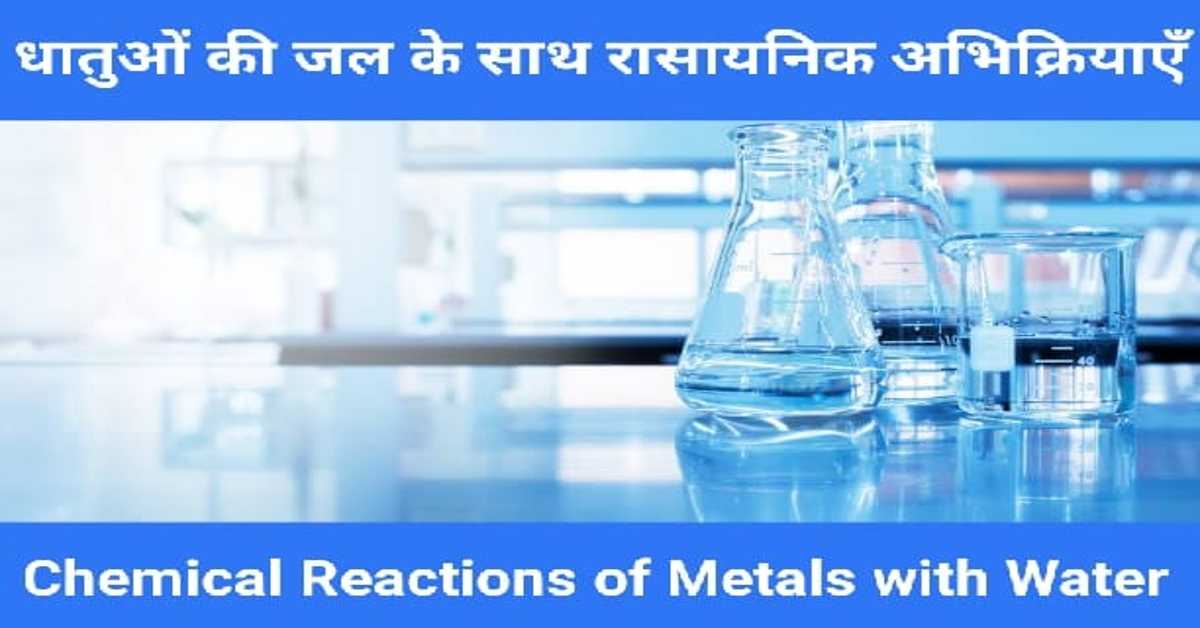
धातुओं की जल के साथ रासायनिक अभिक्रियाएँ | Chemical Reactions of Metals with Water
जब धातुएँ जल के साथ रासायनिक अभिक्रिया करती हैं, तो उत्पाद के रूप में धातु ऑक्साइड प्राप्त होता है। साथ ही हाइड्रोजन गैस मुक्त होती है। कुछ धातु ऑक्साइड जल में घुलनशील होते हैं। जो धातु ऑक्साइड जल में घुलनशील होते हैं, वे जल में घुलकर धातु हाइड्रॉक्साइड प्रदान करते हैं। इन्हें इस प्रकार समझा जा सकता है–
धातु + जल → धातु ऑक्साइड + हाइड्रोजन
धातु ऑक्साइड + जल → धातु हाइड्रॉक्साइड
सभी धातुएँ जल के साथ रासायनिक अभिक्रिया नहीं करती हैं।
When metals react chemically with water, metal oxide is obtained as a product. Also hydrogen gas is liberated. Some metal oxides are soluble in water. Metal oxides that are soluble in water dissolve in water to give metal hydroxides. These can be understood as–
Metal + Water → Metal Oxide + Hydrogen
Metal Oxide + Water → Metal Hydroxide
Not all metals react chemically with water.
रसायन विज्ञान के इन 👇 प्रकरणों को भी पढ़ें। (Also read these 👇 episodes of Chemistry.)
धातुओं की अम्ल, क्षारक और ऑक्सीजन के साथ अभिक्रिया | Reaction Of Metals With Acids, Bases And Oxygen
सोडियम और पोटेशियम धातुएँ ठंडे जल के साथ शीघ्रता से रासायनिक अभिक्रिया करती हैं। ये अभिक्रियाएँ तेज़ एवं ऊष्माक्षेपी होती हैं। इन अभिक्रियाओं के फलस्वरूप उत्सर्जित हाइड्रोजन गैस तत्काल प्रज्वलित हो जाती है। इन अभिक्रियाओं को रासायनिक समीकरण के रूप में इस प्रकार समझा जा सकता है–
2K(s) + 2H2O(l) → 2KOH(aq) (पोटेशियम हाइड्रॉक्साइड) + H2(g) + ऊष्मीय ऊर्जा
2Na(s) + 2H2O(l) → 2NaOH(aq) (सोडियम हाइड्रॉक्साइड) + H2(g) + ऊष्मीय ऊर्जा
Sodium and potassium metals react quickly with cold water. These reactions are rapid and exothermic. The hydrogen gas emitted as a result of these reactions immediately ignites. These reactions can be understood in the form of chemical equations as follows–
2K(s) + 2H2O(l) → 2KOH(aq) (potassium hydroxide) + H2(g) + thermal energy
2Na(s) + 2H2O(l) → 2NaOH(aq) (sodium hydroxide) + H2(g) + thermal energy
रसायन विज्ञान के इन 👇 प्रकरणों को भी पढ़ें। (Also read these 👇 episodes of Chemistry.)
धातुओं और अधातुओं से संबंधित तथ्य | Facts About Metals And Non-Metals
कैल्शियम धातु जल के साथ मंद गति से अभिक्रिया करती है। यह भी ऊष्माक्षेपी अभिक्रिया है। इस अभिक्रिया के फलस्वरुप उत्पन्न हाइड्रोजन प्रज्ज्वलित होने के लिए पर्याप्त नहीं होती है। इस अभिक्रिया में उत्पन्न हाइड्रोजन गैस के बुलबुले कैल्शियम धातु की सतह पर चिपक जाते हैं। इसलिए कैल्शियम जल में तैरना प्रारंभ कर देता है। इस अभिक्रिया को रासायनिक समीकरण के रूप में इस प्रकार समझा जा सकता है–
Ca(s) + 2H2O(l) → Ca(OH)2(aq) (कैल्शियम हाइड्रॉक्साइड) + H2(g)
Calcium metal reacts slowly with water. This is also an exothermic reaction. The hydrogen produced as a result of this reaction is not sufficient to ignite. The bubbles of hydrogen gas produced in this reaction stick to the surface of the calcium metal. Hence calcium starts swimming in water. This reaction can be understood in the form of chemical equation–
Ca(s) + 2H2O(l) → Ca(OH)2(aq) (calcium hydroxide) + H2(g)
रसायन विज्ञान के इन 👇 प्रकरणों को भी पढ़ें। (Also read these 👇 episodes of Chemistry.)
धातुएँ– भौतिक गुणधर्म | Metals– Physical Properties
मैग्नीशियम धातु शीतल जल के साथ रासायनिक अभिक्रिया नहीं करती। यह गर्म जल के साथ अभिक्रिया करती है। मैग्नीशियम धातु की गर्म जल के साथ अभिक्रिया होने पर उत्पाद के रूप में मैग्नीशियम हाइड्रॉक्साइड प्राप्त होता है। साथ ही हाइड्रोजन गैस मुक्त होती है। इस अभिक्रिया में उत्पन्न हाइड्रोजन गैस के बुलबुले मैग्नीशियम धातु की सतह पर चिपक जाते हैं। इसलिए ये धातु जल में तैरना प्रारंभ कर देते हैं।
Magnesium metal does not react chemically with soft water. It reacts with hot water. When magnesium metal is reacted with hot water, magnesium hydroxide is obtained as a product. Also hydrogen gas is liberated. The bubbles of hydrogen gas produced in this reaction stick to the surface of the magnesium metal. Hence these metals start floating in water.
रसायन विज्ञान के इन 👇 प्रकरणों को भी पढ़ें। (Also read these 👇 episodes of Chemistry.)
क्रिस्टलन का जल– जिप्सम और प्लास्टर ऑफ पेरिस | Water Of Crystallisation– Gypsum And Plaster Of Paris
एल्युमीनियम, आयरन और जिंक जैसी धातुएँ न तो शीतल जल के साथ और न ही गर्म जल के साथ अभिक्रिया करती हैं। ये धातुएँ भाप के साथ रासायनिक अभिक्रिया करती हैं। इन धातुओं की भाप के साथ रासायनिक अभिक्रिया होने पर धातु ऑक्साइड प्राप्त होते हैं। साथ हाइड्रोजन गैस मुक्त होती है। इन अभिक्रियाओं को रासायनिक समीकरण के रूप में इस प्रकार समझा जा सकता है–
2Al(s) + 3H2O(g) → Al2O3(s) + 3H2(g)
3Fe(s) + 4H2O → Fe3O4(s) + 4H2(g)
Metals like aluminum, iron and zinc do not react with cold water nor with hot water. These metals react chemically with steam. Metal oxides are obtained by chemical reaction of these metals with steam. With this hydrogen gas is liberated. These reactions can be understood in the form of chemical equations as follows–
2Al(s) + 3H2O(g) → Al2O3(s) + 3H2(g)
3Fe(s) + 4H2O → Fe3O4(s) + 4H2(g)
रसायन विज्ञान के इन 👇 प्रकरणों को भी पढ़ें। (Also read these 👇 episodes of Chemistry.)
धोने का सोडा– निर्माण एवं उपयोग | Washing Soda– Manufacture And Uses
कुछ धातु में ऐसी भी हैं, जो जल के साथ बिल्कुल भी रासायनिक अभिक्रिया नहीं करती हैं। लेड, कॉपर, सिल्वर और गोल्ड जैसी धातुएँ जल के साथ अभिक्रियाएँ नहीं करती हैं।
There are some metals which do not chemically react with water at all. Metals like lead, copper, silver and gold do not react with water.
रसायन विज्ञान के इन 👇 प्रकरणों को भी पढ़ें। (Also read these 👇 episodes of Chemistry.)
बेकिंग सोडा– रासायनिक अभिक्रियाएँ एवं उपयोग | Baking Soda– Chemical Reactions And Uses
आशा है, उपरोक्त जानकारी आपके लिए उपयोगी होगी।
धन्यवाद।
R F Temre
rfcompetition.com
आशा है, उपरोक्त जानकारी उपयोगी एवं महत्वपूर्ण होगी।
(I hope the above information will be useful and important. )
Thank you.
R. F. Tembhre
(Teacher)
pragyaab.com




Comments